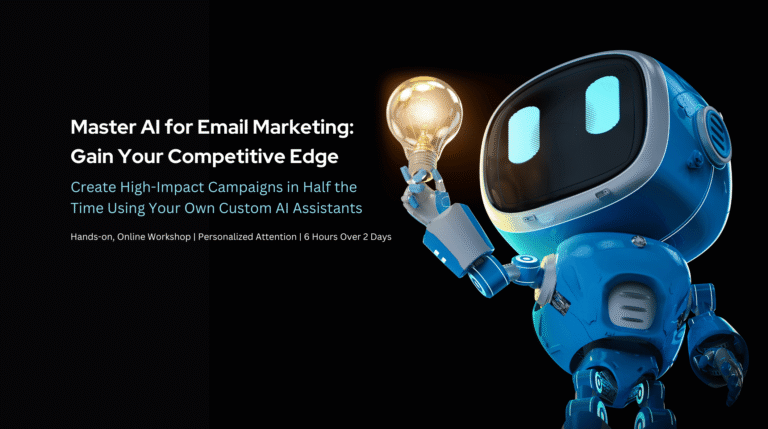Your 90-Day AI Fluency Plan
You know that AI fluency has become essential for staying competitive, but where do you actually start? With new tools launching every week and endless articles about AI’s potential, it’s easy to feel overwhelmed before you even begin.
Here’s what I’ve learned from working with professionals who’ve successfully integrated AI into their work: the difference between those who thrive with AI and those who struggle isn’t technical aptitude, it’s having a methodical approach to skill development.
Rather than jumping between every new AI tool or trying to master everything at once, successful professionals follow a structured 90-day progression that builds genuine fluency without the chaos.
Days 1-30: Building Your AI Foundation
Your first month is about developing what I call “AI literacy”: the ability to think strategically about artificial intelligence in business contexts. This phase sets you apart from people who jump straight into tools without understanding the broader landscape.
Start by understanding the main categories of AI that impact business today. Generative AI creates new content: text, images, code, or data. Predictive AI analyzes patterns to forecast outcomes or identify trends. Automation AI handles routine tasks and processes. Each serves different purposes and works best in different situations.
Learn to recognize quality AI applications in your industry. What are the leading companies in your field doing with AI? How are your competitors positioning their AI capabilities? This research helps you spot opportunities and avoid common pitfalls.
Develop your ability to evaluate AI tools critically. Every new platform promises revolutionary results, but successful professionals ask better questions: What specific problem does this solve? How does it integrate with existing workflows? What are the security and privacy implications? What happens when it doesn’t work as expected?
Pay attention to AI governance and ethics discussions in your industry. Understanding the responsible use of AI positions you as someone who thinks strategically about implementation rather than just tactically about tools.
Most importantly, start identifying your own high-value use cases. Where do you spend time on repetitive tasks? What decisions require analyzing large amounts of information? Which aspects of your work could benefit from creative input or fresh perspectives? These insights guide your tool selection in the next phase.
Days 31-60: Hands-On Practice with Purpose
Month two is where you transition from learning about AI to actually using it. But instead of experimenting randomly, you’ll focus on 2-3 tools that directly address challenges you identified during your foundation phase.
Choose your tools strategically. If you spend significant time writing (emails, reports, proposals) start with a strong language model like ChatGPT, Claude, or Gemini. If you work with data and analysis, explore AI features in Excel or try dedicated analytics tools. If visual content is important to your role, experiment with image generation or design tools.
The key is depth over breadth. Rather than trying five different tools superficially, master two tools completely. Learn their strengths, understand their limitations, and develop workflows that consistently produce good results.
This is where prompting skills become crucial. Think of prompting like interviewing: the quality of your questions determines the value of the answers you get. Start with clear, specific requests. Instead of “write a marketing email,” try “write a professional email to existing customers announcing our new service, focusing on the time-saving benefits and including a clear call-to-action to schedule a demo.”
Practice with real projects, not hypothetical exercises. Use AI to help with actual work you need to complete. This approach gives you immediate value while building skills in realistic contexts. You’ll discover nuances and applications that theoretical practice never teaches.
Measure your results quantitatively whenever possible. Time savings, quality improvements, creative options generated—these metrics help you understand where AI adds the most value to your specific work style and responsibilities.
Days 61-90: Integration and Strategic Application
Your final month focuses on sophistication and leadership. By now, you have foundational knowledge and practical experience with core tools. This phase is about combining capabilities, handling complex workflows, and beginning to guide others.
Start experimenting with multi-tool workflows. Maybe you use AI for initial research, then another tool for analysis, and a third for presentation creation. Or you might use AI to generate multiple content variations, then combine the best elements into a final version. These integrated approaches often produce better results than single-tool solutions.
Tackle more complex challenges that require sustained AI collaboration. Instead of using AI for quick tasks, work on projects that require multiple iterations, refinement, and strategic thinking. This might be developing a comprehensive marketing strategy, analyzing a complex business problem, or creating a detailed project plan.
Begin sharing your knowledge with colleagues. Teaching others accelerates your own learning and positions you as a resource in your organization. Start small: maybe share a useful prompt with your team or demonstrate how you’re using AI for a specific task. Pay attention to their questions and challenges, as these insights often reveal new applications you hadn’t considered.
This is also when you should start thinking about AI’s role in your broader career strategy. How can these capabilities help you take on new responsibilities? What opportunities might emerge as your organization adopts AI more broadly? How can you position yourself as someone who bridges business strategy and AI implementation?
Consider the governance and ethical implications of your AI use more deeply. As you become more sophisticated in your applications, you’ll encounter situations that require judgment about appropriate use, data privacy, and transparency. Developing clear principles for responsible AI use sets you apart as a thoughtful practitioner.
Beyond 90 Days: Maintaining Your Competitive Edge
AI fluency is an ongoing capability that requires regular attention. The tools will continue evolving, new use cases will emerge, and your own skills will need periodic updating.
Plan for quarterly skill reviews. Every three months, assess what’s working in your AI toolkit, what new capabilities might be valuable, and how your use cases are evolving. This regular maintenance keeps your skills current without requiring constant attention to every new development.
Build relationships with other AI-fluent professionals. The most successful practitioners I work with have informal networks of colleagues who share insights, troubleshoot challenges, and discuss emerging opportunities. These relationships provide ongoing learning and support as the technology continues advancing.
Remember that AI fluency is ultimately about judgment, not just technical skills. The professionals who create the most value with AI aren’t necessarily the ones who know every feature of every tool—they’re the ones who understand when and how to apply these capabilities strategically.
Your 90-day plan gives you something most of your colleagues won’t have: systematic experience with AI applied to real business challenges. This foundation positions you to adapt as the technology evolves and to help guide your organization’s AI adoption.
The investment you make in the next 90 days will compound for years. While others debate whether to start, you’ll be refining approaches that already work. While they experiment randomly, you’ll have proven frameworks. While they worry about being left behind, you’ll be helping to lead the way forward.
Ready to start your own 90-day AI fluency plan? If you’d like guidance on adapting this framework to your specific role and goals, reach out. I help professionals build AI capabilities that create real competitive advantages, without the overwhelm or hype.







